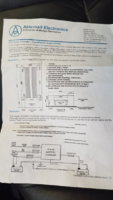My electrical system for the van is composed of an Xtreme 110ah leisure battery (XR1750Dc), Sargent EC155 PSU and Ablemail 12-12-30 charger. I'd hoped that regular weekly runs up north and return of 3-500 miles would keep the battery charged but realise I've been too optimistic and the battery while showing nigh on 100% on arrival after a drive of several hours literally ticks back down to 80% in minutes, using lights only, where it seems to settle before dropping at a more agreeable rate. I don't use hookup or mains charging, the battery is less than a year old.
Questions :
1. Am I right in thinking that lack of mains charging has caused my battery to deteriorate to it's reduced capacity ?
2. Do I need a mains charger to sit between the house mains and the battery, and use it on a weekly basis ?
3. What is the Ablemail charger actually doing ?
4. Can the EC155 power up the battery to 100% via mains ?
I'm thinking of the coming winter and I'd be willing to pay (again!) for a new battery if I could be sure of having near 100% capacity available to power my HS2000 heater and LED lighting for overnighting at somewhere cold like a ski centre car park in the Highlands, that's not a huge power draw but I've no confidence that my battery will provide that given the cold temperature and the 50% discharge limit. If it's 10 degrees in the van on arrival am I right in thinking the battery is about 20% down to start with so I'm looking at something like a useable 30ah or so out of a fully charged 110ah battery?
To complicate matters, the reason I barely use the mains for charging is the hassle of running the cable from
the back of the house to the drive, the battery itself is low profile and sits under the drivers seat so there isn't much room for regular attaching and detaching charging leads to the battery, a more permanent fix would be required.
Any tips, suggestions welcome and feel free to put any misconceptions straight, I've never quite got my head around the setup.
Questions :
1. Am I right in thinking that lack of mains charging has caused my battery to deteriorate to it's reduced capacity ?
2. Do I need a mains charger to sit between the house mains and the battery, and use it on a weekly basis ?
3. What is the Ablemail charger actually doing ?
4. Can the EC155 power up the battery to 100% via mains ?
I'm thinking of the coming winter and I'd be willing to pay (again!) for a new battery if I could be sure of having near 100% capacity available to power my HS2000 heater and LED lighting for overnighting at somewhere cold like a ski centre car park in the Highlands, that's not a huge power draw but I've no confidence that my battery will provide that given the cold temperature and the 50% discharge limit. If it's 10 degrees in the van on arrival am I right in thinking the battery is about 20% down to start with so I'm looking at something like a useable 30ah or so out of a fully charged 110ah battery?
To complicate matters, the reason I barely use the mains for charging is the hassle of running the cable from
the back of the house to the drive, the battery itself is low profile and sits under the drivers seat so there isn't much room for regular attaching and detaching charging leads to the battery, a more permanent fix would be required.
Any tips, suggestions welcome and feel free to put any misconceptions straight, I've never quite got my head around the setup.




